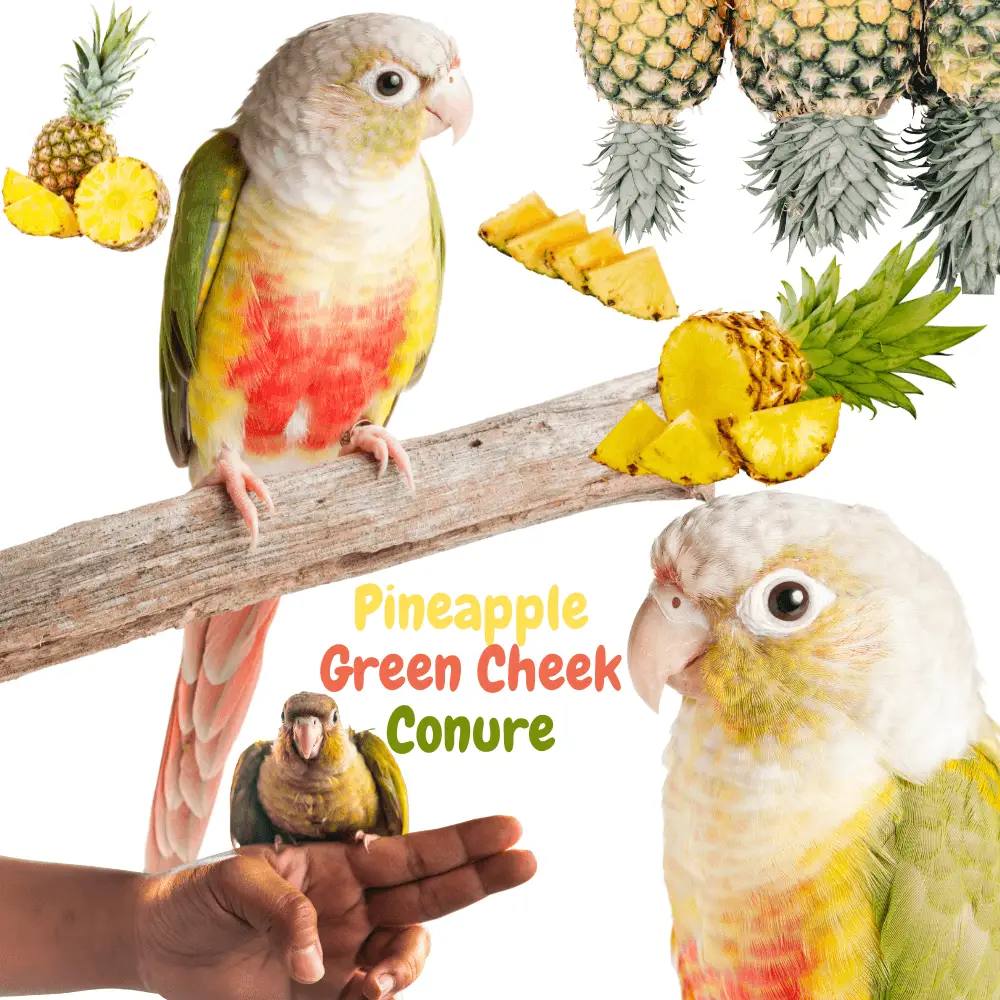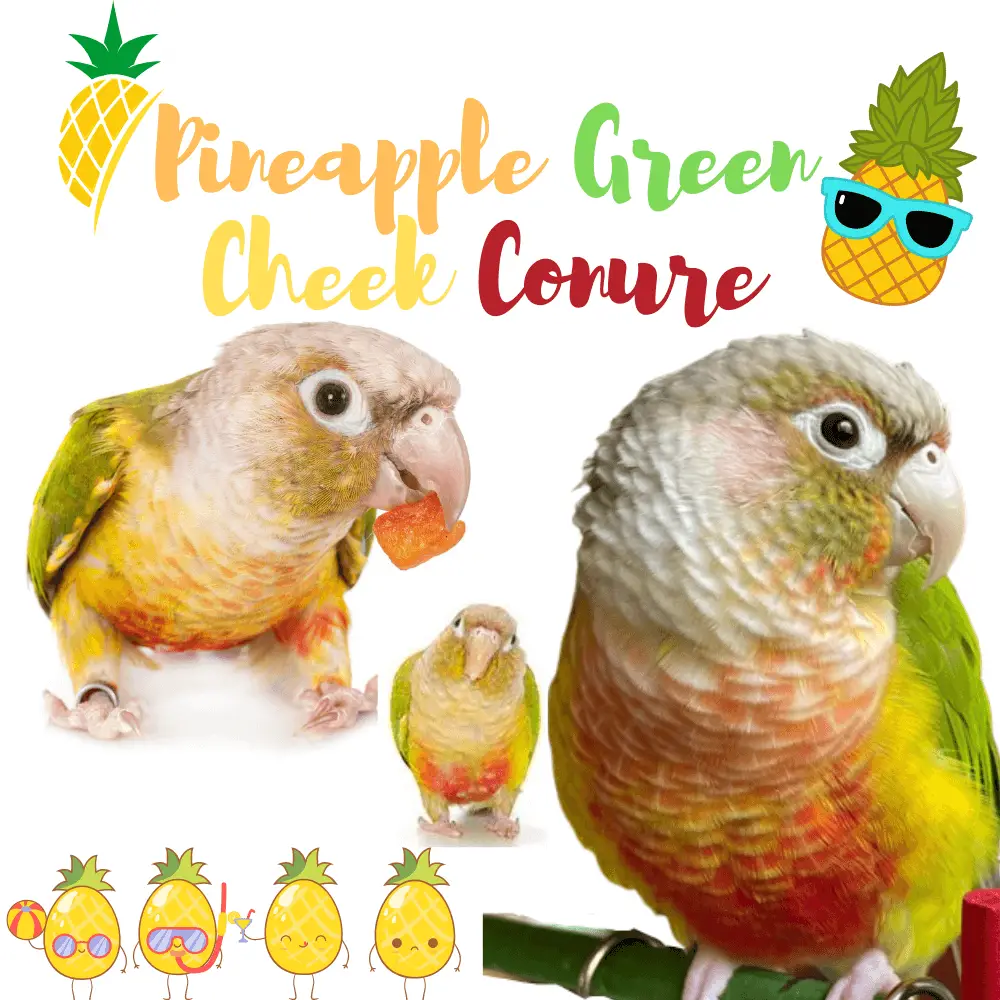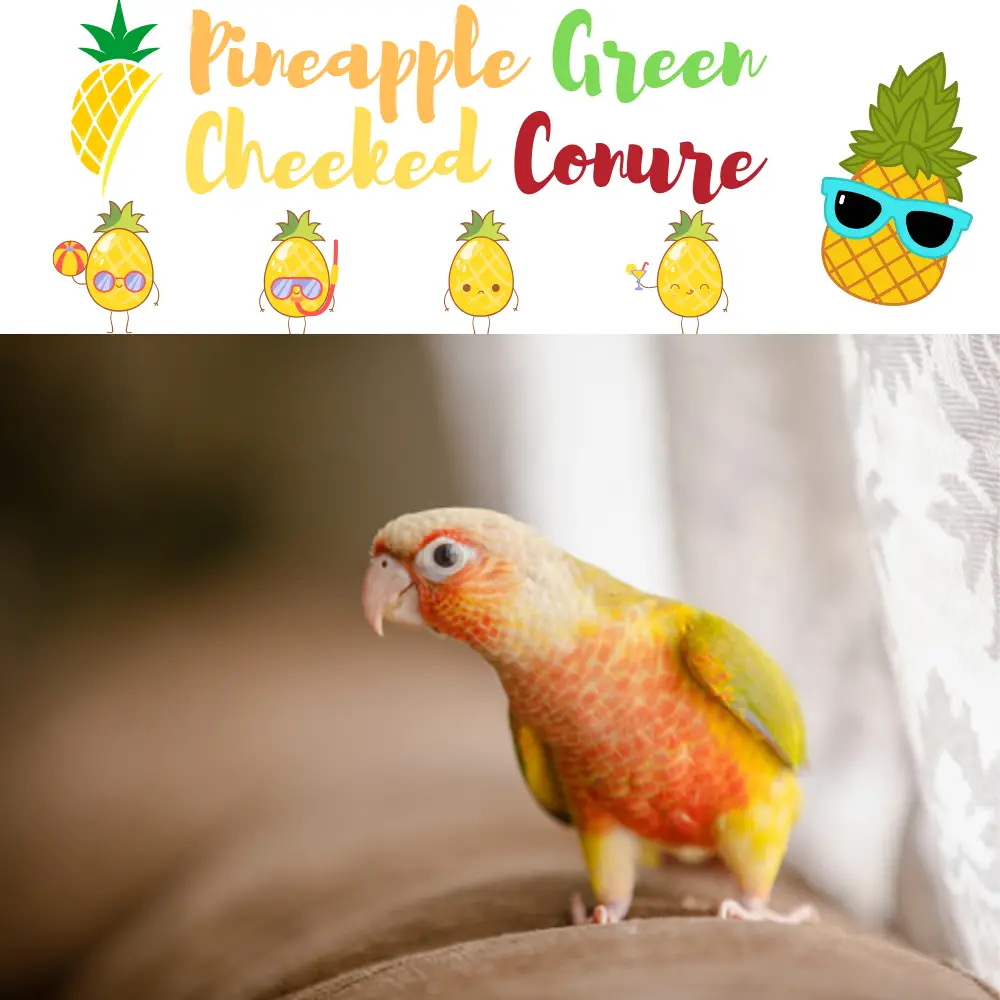
Pineapple Green Cheek Conures are a popular choice for bird enthusiasts due to their vibrant colors, playful personalities, and relatively small size. These birds are native to South America and can be found in the wild in countries such as Brazil, Bolivia, and Argentina.
What Is a Pineapple Green Cheek Conure?
In recent years, they have become increasingly popular as pets due to their affectionate nature and ability to bond closely with their owners. In this comprehensive guide, we will explore the physical characteristics, behavior, and care of Pineapple Green Cheek Conures to help you decide if these birds are the right fit for your home.
For more information about other conure types :
- Green cheeked conure
- Jenday conure
- Blue-crowned conure
- Sun conure aratinga solstitialis
- Golden conure
What is the size of Pineapple Green Cheek Conures?
Pineapple Green Cheek Conures are medium-sized birds that measure around 10 inches in length. They have a predominantly green body with yellow and red feathers on their head, neck, and chest, giving them a distinct pineapple-like appearance. Their beaks are short and curved, which they use to crack open nuts and seeds.
In captivity, Pineapple Green Cheek Conures require a spacious cage that is at least 24 inches wide, 24 inches deep, and 30 inches tall. The cage should have plenty of perches, toys, and swings to keep them entertained and stimulated. It’s also important to provide them with fresh water and food daily, as well as regular cleaning of their cage to maintain their hygiene.
What country is the green cheek conure from
These conures are native to South America, specifically in the forests of Brazil, Bolivia, and Argentina. In the wild, they live in flocks and prefer habitats with dense vegetation, such as rainforests and savannas.
How Much Is a Pineapple Green Cheek Conure?
Buying a parrot can be a challenge, as there are many factors to consider. If you have owned birds before, you may want to purchase an older bird that has been trained and socialized. They are often more expensive due to their age and dressage status.
The pineapple green-cheeked conure can cost between $300 and $700 depending on the breeder and where you buy it.
Other factors contribute to the price, including lineage, the sex of the Pineapple Green-cheeked Conure, and any additional characteristics such as color mutations.
If you are looking for a green cheek pineapple conure an animal sanctuary or a private pet shop then the cost is around $300 to $600 depending on whether it is male or female, with costlier variations ranging from $700 depending on sex, age, and lineage.
How Long Do Pineapple Green Cheek Conures Live?
The Pineapple Green cheeked conure lifespan is 30 years. Its life expectancy in captivity can go up to 25 years, even 30, if it is raised in good conditions and good healthy diet and nutrition.

Pineapple Green Cheek Conure Personality
In addition to their cage, Pineapple Green Cheek Conures also need time outside of their enclosure for exercise and socialization. They enjoy interacting with their owners and can learn to perform tricks and mimic sounds with proper training.
Overall, Pineapple Green Cheek Conures are active and playful birds that require a lot of attention and care. By providing them with suitable habitats and meeting their physical and emotional needs, you can ensure that they thrive in your home.
Pineapple Green-Cheeked Conure Behavioral Problems
Green-cheeked pineapple conures are known to be more active and playful than pineapples; however, behavioral issues can arise due to poor socialization with humans. A green-cheeked pineapple conure that hasn’t had much social interaction with humans will squeal more often because it’s the only way to get attention and show displeasure at something.
Aggressiveness
Pineapple conures are naturally playful creatures, but they can become aggressive and destructive if left alone for too long. Signs that the bird is starting to get upset are:
-Plumes ébouriffées
-A squatting position or a lowered head.
-Sway from side to side of the cage as a sign of aggression.
The Pineapple Conure’s eyes also change size rapidly when agitated – they grow larger or smaller depending on the animal’s mood at any given time.
Mordant
Like most other conures, green-cheeked pineapple conures have an annoying habit of biting. This is more common in young, unsocialized pineapple conures who suffer from trauma from being rehomed or who are moody after being spoiled.
Are Pineapple Green Cheek Conures Intelligent?
Pineapple Green Cheek Conures are known for their playful and affectionate nature. They are highly social birds that thrive on interaction with their owners and other birds. These birds are intelligent and curious, and they love to explore their surroundings.
One of the most endearing personality traits of Pineapple Green Cheek Conures is their ability to form strong bonds with their owners. They are loyal and affectionate birds that enjoy spending time with their human companions. They will often seek out attention and affection from their owners, and they can become quite vocal if they feel neglected.
Pineapple Green Cheek Conures are also known for their playful nature. They love toys and games, and they enjoy interacting with their owners in a variety of ways. They are highly active birds that require plenty of mental stimulation to stay happy and healthy.
Do Pineapple Green Cheek Conures Talk?
Another interesting behavior of Pineapple Green Cheek Conures is their tendency to mimic sounds and words. While they may not be as skilled at talking as some other parrot species, they can learn to repeat simple phrases and sounds with practice and patience.
Conures are highly vocal birds and use a variety of sounds to communicate with their owners and other birds. In this article, we will explore the different types of vocalizations that Pineapple Green Cheek Conures make and how to interpret their meaning. We will also provide tips on how to communicate effectively with your Pineapple Green Cheek Conure to strengthen your bond and enhance your relationship.
What Sounds Do Pineapple Green Cheek Conures Make?
Common Vocalizations of Pineapple Green Cheek Conures: Pineapple Green Cheek Conures are known for their lively and talkative nature. They have a wide range of vocalizations that they use to communicate with their owners and other birds. Some of the most common sounds that Pineapple Green Cheek Conures make include chirps, chatters, squawks, screams, and whistles.
Chirps
Chirps are the most common sound that Pineapple Green Cheek Conures make. They use this sound to greet their owners, show affection, and express happiness. Chirps can be short and sweet or long and drawn out, depending on the situation.
Chatters
Chatters are another common sound that Pineapple Green Cheek Conures make. This sound is similar to a human’s chatter and is often used when the bird is excited or happy. Chatters can also be used as a way to get attention from their owners.
Squawks
Squawks and screams are the loudest vocalizations that Pineapple Green Cheek Conures make. They use these sounds to express fear, anger, or frustration. Squawks and screams can be alarming to hear, but they are a normal part of the bird’s communication.
Whistles
Whistles are another common sound that Pineapple Green Cheek Conures make. They use whistles to mimic sounds in their environment or to communicate with other birds. Whistles can be short and simple or complex and melodic.
Overall, Pineapple Green Cheek Conures have a diverse range of vocalizations that they use to communicate with their owners and other birds. Understanding these sounds is an important part of building a strong bond with your feathered friend.
Understanding the Meaning Behind Pineapple Green Cheek Conure Sounds
Pineapple Green Cheek Conures are known for their vocalizations and communication skills. As a pet owner, it’s important to understand the meaning behind their sounds to better communicate with them.
One of the most common sounds that Pineapple Green Cheek Conures make is a high-pitched chirp. This sound can mean many things, such as excitement, happiness, or even fear. It’s important to pay attention to your conure’s body language when they make this sound to determine what they’re feeling.
Another sound that Pineapple Green Cheek Conures make is a low growl or hiss. This sound usually indicates that they’re feeling threatened or uncomfortable. If you hear this sound, it’s best to give your conure some space and try to identify what might be causing them to feel uneasy.
Pineapple Green Cheek Conures also make a variety of other sounds, such as whistles, squawks, and screams. These sounds can have different meanings depending on the context in which they’re made. For example, a loud scream could indicate that your conure is in distress or pain, while a soft whistle might mean that they’re content and relaxed.
By paying close attention to your Pineapple Green Cheek Conure’s vocalizations and body language, you can better understand their needs and emotions. This will help you build a stronger bond with your pet and create a happier, healthier relationship.

Tips for Communicating with Your Pineapple Green Cheek Conure
When it comes to communicating with your Pineapple Green Cheek Conure, there are a few things you can do to establish a strong bond and ensure that your bird feels comfortable around you. Here are some tips to help you communicate effectively with your feathered friend:
Spend time with your conure
One of the best ways to communicate with your Pineapple Green Cheek Conure is by spending time with them. This means interacting with them on a daily basis, whether it’s through talking, playing, or simply being in the same room as them. The more time you spend with your bird, the more they will trust you and feel comfortable around you.
Use positive reinforcement
When your Pineapple Green Cheek Conure does something good, such as learning a new trick or behaving well, be sure to reward them with treats or praise. This positive reinforcement will encourage your bird to continue its good behavior and will strengthen your bond with them.
Learn their body language
Just like humans, birds have their own unique body language that can tell you a lot about how they’re feeling. By learning to read your Pineapple Green Cheek Conure’s body language, you’ll be able to better understand their needs and communicate with them more effectively.
Be patient
Communicating with your Pineapple Green Cheek Conure takes time and patience. Don’t expect your bird to understand everything you say right away, and don’t get frustrated if they don’t respond the way you want them to. With time and practice, you’ll develop a strong bond with your bird and be able to communicate with them in a way that works for both of you.
By following these tips, you’ll be able to establish a strong bond with your Pineapple Green Cheek Conure and communicate with them effectively. Remember to be patient, use positive reinforcement, and spend time with your bird every day to build a strong relationship that will last a lifetime.
Do Pineapple Green Cheek Conures Make Good Pets?
Overall, Pineapple Green Cheek Conures are delightful pets that make great companions for bird lovers of all ages. With proper care and attention, these birds can live long, healthy, and happy lives.
The pineapple green cheek conure has these traits:
- Intelligent: Pineapple Green Cheek Conures is happy to learn new tricks.
- Loving: Pineapple Green Cheek Conures enjoy being handled and petted.
- Outgoing: Pineapple Green Cheek Conures have a cheeky an
- Caring: Pineapple Green Cheek Conures love spending time with their owners.
Are Pineapple Green Cheek Conures Good for Beginners
Yes and big *YES Pineapple green cheek conures are good beginner parrots because they are easy to care like budgies and cockatiels and lovebirds
How To Take Care of A Pineapple Green Cheek Conure
Care and Maintenance of Pineapple Green Cheek Conures
Caring for Pineapple Green Cheek Conures requires a lot of attention and effort. Here are some tips to ensure that your bird stays healthy and happy:
Diet
A balanced diet is essential for the health of your Pineapple Green Cheek Conure. Feed them a variety of fresh fruits, vegetables, and high-quality pellets. Avoid feeding them avocado, chocolate, caffeine, and alcohol as they are toxic to birds.
Cage
Provide a spacious cage with enough room for your bird to move around and stretch its wings. The cage should be cleaned regularly, and the bedding should be changed frequently.
Toys and Enrichment
Pineapple Green Cheek Conures are intelligent birds and need mental stimulation. Provide them with toys, perches, and other forms of enrichment to keep them entertained.
Exercise
Allow your bird to exercise by providing them with ample time outside their cage. Supervise them during playtime to ensure their safety.
Grooming
Regular grooming is essential for the health of your Pineapple Green Cheek Conure. Trim their nails, clean their beak, and bathe them regularly.
Health Checkups
Take your bird to a veterinarian regularly for checkups. Birds are good at hiding illness, so it’s important to catch any health issues early on.
By following these tips, you can ensure that your Pineapple Green Cheek Conure lives a long and healthy life.
What Do Pineapple Green Cheek Conures Eat?
The Pineapple Green Cheek Conures Can Eat
- Pellets
- Fruits and Vegetables
- Seeds
- Nuts
Pineapple Green Cheek Conures have specific nutritional needs that must be met to ensure their health and well-being. These birds require a balanced diet that includes a variety of nutrients, including protein, carbohydrates, fats, vitamins, and minerals.
One essential nutrient for Pineapple Green Cheek Conures is protein. These birds need a source of high-quality protein to maintain healthy feathers and muscles. Good sources of protein include cooked chicken, eggs, and beans.
Carbohydrates are also an important part of a conure’s diet. They provide energy and help regulate blood sugar levels. Fruits such as apples, bananas, and grapes are excellent sources of carbohydrates for Pineapple Green Cheek Conures.
Fats are another essential nutrient for these birds. They provide energy and help with the absorption of vitamins. However, it’s important to provide healthy sources of fat, such as nuts and seeds, in moderation.
In addition to protein, carbohydrates, and fats, Pineapple Green Cheek Conures require a variety of vitamins and minerals. Vitamin A is crucial for maintaining healthy eyesight and skin, while calcium is necessary for strong bones. Dark leafy greens, carrots, and sweet potatoes are excellent sources of vitamin A, while dairy products and eggshells can provide calcium.
Overall, providing a balanced and varied diet is key to meeting the nutritional needs of Pineapple Green Cheek Conures.
Recommended Diet for Pineapple Green Cheek Conures
When it comes to feeding Pineapple Green Cheek Conures, it’s important to provide them with a balanced and varied diet. A good diet for these birds should consist of high-quality pellets, fresh fruits, vegetables, and occasional treats.
Pellets should make up the majority of their diet, as they contain all the necessary nutrients that these birds need to thrive. Choose pellets that are specifically formulated for conures, as they will have the right balance of protein, fat, and carbohydrates. It’s important to avoid seed-based diets, as they are often deficient in essential nutrients and can lead to health problems.
In addition to pellets, fresh fruits and vegetables should be offered daily. These can include leafy greens, carrots, sweet potatoes, apples, grapes, and berries. Be sure to wash all produce thoroughly before offering it to your bird.
Treats should be given sparingly, as they can be high in sugar and fat. Good options for treats include unsalted nuts, whole grains, and cooked eggs.
It’s also important to provide your Pineapple Green Cheek Conure with fresh water at all times. Change the water daily and clean the water dish regularly to prevent bacterial growth.
Remember, a healthy diet is key to keeping your Pineapple Green Cheek Conure happy and thriving.
Tips for Feeding Pineapple Green Cheek Conures
When it comes to feeding Pineapple Green Cheek Conures, there are a few tips that can help ensure they receive the proper nutrition. First and foremost, it’s important to provide a variety of fresh fruits and vegetables in addition to their pellet diet. This will help ensure they receive a range of vitamins and minerals.
It’s also important to avoid feeding them foods that are high in fat or sugar, as these can lead to health issues such as obesity and diabetes. Additionally, be sure to remove any uneaten food from their cage after a few hours to prevent spoilage and bacterial growth.
Another tip is to offer treats in moderation. While it’s okay to give your conure a small number of seeds or nuts as a treat, too much can lead to an unbalanced diet and potential health problems.
Finally, make sure your conure has access to clean, fresh water at all times. Change their water daily and clean their water dish regularly to prevent bacterial growth.
By following these tips, you can help ensure your Pineapple Green Cheek Conure receives a healthy and balanced diet.
What Foods Are Bad for Pineapple Green Cheek Conures?
in this list you can find unhealthy and toxic for your parrot Never feed a pineapple green cheek conure the following foods :
- Avocado
- Caffeine
- Coffee
- Salt
- Fat
- Fruit pits and apple seeds
- Chocolate
- Onions and garlic
- Xylitol
Also, avoid feeding pet parrots human junk food.
Pineapple Green Cheek Conure Health
like all pets, they require proper care and attention to maintain good health. In this article, we will discuss common health problems that Pineapple Green Cheek Conures may face, preventative measures to keep them healthy, and treatment options if they do become ill.
Pineapple Green Cheek Conure Health Problems
Common Health Problems in Pineapple Green Cheek Conures: Pineapple Green Cheek Conures are generally healthy birds, but like any other living creature, they are susceptible to certain health problems. Some of the common health issues that Pineapple Green Cheek Conures may experience include respiratory infections, feather plucking, and digestive problems.
Respiratory infections
Respiratory infections are one of the most common health problems in Pineapple Green Cheek Conures. These infections can be caused by a variety of factors such as poor ventilation, exposure to drafts, or bacterial infections. Symptoms of respiratory infections include sneezing, coughing, wheezing, and difficulty breathing.
Feather plucking
Feather plucking is another common health problem in Pineapple Green Cheek Conures. This behavior can be caused by stress, boredom, or nutritional deficiencies. Feather plucking can lead to skin irritation and infections, which can further exacerbate the problem.
Digestive problems
Digestive problems are also common in Pineapple Green Cheek Conures. These birds are prone to gastrointestinal issues such as diarrhea, constipation, and crop impaction. These problems can be caused by a poor diet, lack of exercise, or bacterial infections.
It is important to keep an eye on your Pineapple Green Cheek Conure’s behavior and physical condition to catch any potential health problems early on. Regular check-ups with a veterinarian who specializes in avian care can also help ensure that your bird stays healthy and happy.
Polyomavirus
The Signs of Polyomavirus Disease in Pineapple Green Cheek Conures:
- Lethargy
- Vomiting
- Swollen abdomen
- Loss of appetite
- Regurgitation
- Weight loss
- Sudden death
- Breathing difficulties
Chlamydiosis
The Signs of Chlamydiosis Disease in Pineapple Green Cheek Conures:
- Appetite loss
- Difficulty moving or flying
- Coughing
- Lime droppings
- Conjunctivitis (red eye)
- Fluffed feathers
- Beak discharge
Psittacosis
The Signs of the Psittacosis Disease in Pineapple Green Cheek Conures:
- Discharge from eyes and beak
- Yellow or green droppings
- Reduced vocalization
- Crusty eyes Swollen, watery
- Reduced appetite
- Depression
- Weight loss
- Weakness
Aspergillosis
The Signs of the Aspergillosis Disease in Pineapple Green Cheek Conures:
- Fluffed feathers
- Tail bobbing
- Weight loss
- Listlessness
- Lethargy
Psittacine Beak and Feather Disease
- Beak and claw deformities
- Yellow contour feathers
- Sudden death
- Secondary infections
Treatment Options for Pineapple Green Cheek Conure Health Problems
When it comes to treating health problems in Pineapple Green Cheek Conures, it’s important to first identify the issue at hand. Some common health problems in these birds include respiratory infections, feather plucking, and digestive issues.
For respiratory infections, a veterinarian may prescribe antibiotics or other medications to help clear up the infection. Feather plucking can be a behavioral issue, so addressing any underlying stressors or providing environmental enrichment can help alleviate the problem.
Digestive issues, such as diarrhea or constipation, may require dietary changes or medication to regulate bowel movements. It’s important to always consult with a veterinarian before administering any medication to your bird.
In addition to medical treatment, providing a clean and healthy environment for your Pineapple Green Cheek Conure is crucial for their overall health and well-being. This includes regular cage cleaning, fresh food and water, and plenty of opportunities for exercise and mental stimulation.
Preventative Measures for Pineapple Green Cheek Conure Health Issues
As a responsible pet owner, it’s important to take preventative measures to keep your Pineapple Green Cheek Conure healthy. Here are some tips to help you prevent health issues in your bird:
Provide a Balanced Diet
A balanced diet is essential for the overall health of your Pineapple Green Cheek Conure. Make sure their diet includes fresh fruits, vegetables, and high-quality pellets. Avoid feeding them sugary or fatty foods.
Keep Their Cage Clean
Regularly clean your bird’s cage to prevent the buildup of bacteria and other harmful microorganisms. Use a safe disinfectant to clean the cage and its accessories.
Monitor Temperature and Humidity
Pineapple Green Cheek Conures are sensitive to temperature and humidity changes. Keep their environment at a consistent temperature and humidity level to prevent respiratory problems.
Regular Vet Checkups
Schedule regular checkups with an avian veterinarian to ensure your Pineapple Green Cheek Conure is healthy. Your vet can also provide advice on how to prevent health issues.
Exercise and Socialization
Allow your Pineapple Green Cheek Conure to exercise and socialize regularly. This will help keep them mentally and physically healthy.
By following these preventative measures, you can help keep your Pineapple Green Cheek Conure healthy and happy.




















